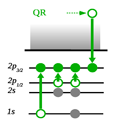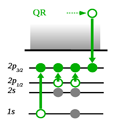Crowded Recombination
Dielectronic recombination, the resonant capture of a free electron by an ion, is a fundamental process in atomic physics and is of significant relevance to the fields of plasma physics and astrophysics. Calculations involving recombination processes often take into consideration interactions between only two electrons, neglecting higher-order correlations, especially the intershell ones, on the assumption that their contribution is minimal.
In an article appearing in Physical Review Letters, Christian Beilmann at the Max Planck Institute for Nuclear Physics in Heidelberg, Germany, and colleagues report measurements with unexpectedly strong higher-order contributions to electronic recombination. Despite the large momentum and energy transfers involved in these intershell processes, the researchers observe them in several ionized elements such as iron, krypton, and argon. The highly charged ions are generated using an electron beam ion trap where a K-shell electron interacts during recombination with one or two L-shell electrons. These experimental results are in good agreement with theoretical predictions and, surprisingly, show a strong increase in the high-order resonance strengths for ions with a low atomic number. These observations will likely solve puzzling discrepancies between theory and experiments. – Jihane Mimih





